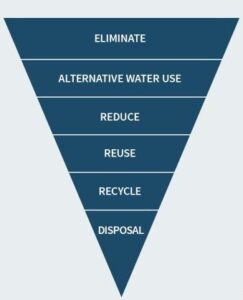It’s been a GREAT Summer! We’ve had weeks of pure, blissful sunshine and temperatures reaching up to 40C across the UK. But this summer has also seen one of the worst droughts in Europe with two-thirds of the continent under drought warning, the worst such event in 500 years.
The impact this has had, and is having, is huge; crop production has declined up to 18% whilst the lack of water in rivers has caused havoc for biodiversity. In the UK, this summer has been recorded as being the driest in 50 years with hosepipe bans covering the country, and with climate change contributing to more frequent extreme weather, droughts like this are expected to become more common. More must be done to conserve and manage water more appropriately by water companies, industry, government, and individuals.
Industry consumes vast amounts of water, with the construction industry alone consuming considerable amounts of this. Just in day-to-day operations on-site water is used for general site activities such as tool washing, wet trades (brickwork, concreting, plastering), dust suppression, groundworks (grouting and drilling), hydro-demolition, and the commission and testing of building services. A number of these operations are also responsible for water wastage, providing opportunities to address water usage and reduce overall consumption; so what can be done on-site to reduce water consumption?
One of the most cost-effective ways to reduce water consumption is by incorporating water saving principles into all aspects during the design of the project. This could include preparing a water saving action plan that identifies areas where water consumption is highest and implementing actions that can be taken to reduce this.
Ensuring that everyone is involved and aware of their responsibilities within the plan can increase engagement and contribute to higher savings on water consumption. For all new and existing on-site staff, provide training that demonstrates the type of actions that can be taken and the benefits the programme will bring. Make sure to keep track of all progress made so that problem areas can be identified and achievements can be celebrated. Installing water metres is a great way of being able to monitor this progress.
Within the design phase and when working on-site consider the Water Management Hierarchy to determine which actions could be taken to reduce water consumption. Prioritise eliminating the use of water and attempting to reduce disposal as much as possible. Ideas of each can be seen below.

Rather than using water in a process consider an alternative that allows for water to be eliminated completely; for example, can workers use a broom to clean paths and gutters rather than water? Can compressed air be used as a substitute for cleaning equipment instead of water? Consider waterless urinals and other such equipment.
Avoid using mains water by collecting rainwater in tanks, dams or even swimming pools. Also attempt to utilise sustainable urban drainage systems (SUDS*) on-site to capture water. Use the collected greywater to supply toilets and showers or to clean equipment and be used in cleaning processes where mains water may not be necessary.
Reduce the use of water through switching to water-saving devices such as aerated taps, sensor-controlled taps, low-flush toilets or hoses with triggers (that supply water only when needed rather than constantly running). If possible, use buckets of water to clean equipment rather than running water. Ensure that pipes and taps supplying the water are maintained on a regular basis to avoid water being lost through leakages.
If possible re-use the water from processes on-site including using water from sinks to clean outdoor equipment or to irrigate plants. Always ensure that this is safe to do so however, and consider water filtration systems that can allow for water to be treated and then recycled back into a system.
If there is no alternative to disposing of the water, ensure that this is done safely and meets the disposal requirements outlined nationally, regionally and on the specific project.
Heatwaves and droughts are expected to become a more common feature of the British summer, providing incentive to begin acting now to save water. But the benefits go beyond just reducing consumption; reducing the amount of water used can reduce the amount of water that needs to be treated before being released back into the mains system, also contributing to reduced costs.
With increasing interest around sustainability and water use, incentive to design buildings with more efficient water use post-construction also exists; think beyond how you can incorporate a water action plan on-site but also to how water-saving techniques can be incorporated post-construction, through the installations, appliances, and the design of buildings. As concern grows around water usage adapting now could save in the long-term.
For more information on how you could reduce your water usage and improve water efficiency please contact Sam Walker.
Looking for tips on reducing your energy consumption too? Sam’s got your covered here.
*Sustainable Urban Drainage System – A drainage solution that provides an alternative to the direct channelling of surface water through networks of pipes and sewers to nearby watercourses. These mimic natural draining systems, reducing surface water flooding, improving water quality and allowing for water to be stored.

Sam Walker
Consultant Researcher
sam.walker@actionsustainability.com

This was posted in All Topics, Energy & Carbon, ISO 20400 Sustainable Procurement
Our Head of Climate, Dr James Cadman, shares his insights on how organisations can effectively embed carbon reduction into their sustainable procurement practices using the ISO 20400 framework.
Read Article
This was posted in Energy & Carbon, ISO 20400 Sustainable Procurement
Developed by Action Sustainability, "Responsible Sourcing of HVO – A Comprehensive Guide" explores how to responsibly procure Hydrotreated Vegetable Oil (HVO).
Read Article
This was posted in Energy & Carbon, Sustainability Strategy
Action Sustainability is partnering with SKAO for the launch of the CO2 Performance Ladder pilot in the United Kingdom.
Read Article